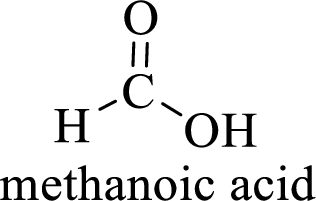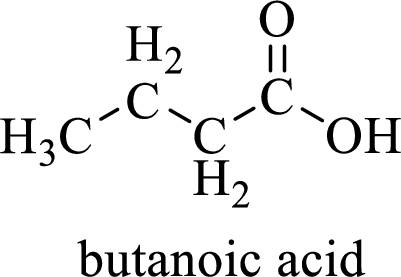
Concept explainers
(a)
Interpretation:
The name for
Concept Introduction:
Any organic molecule can be named by using certain rules given by IUPAC (International Union for Pure and applied chemistry). IUPAC name consists of three parts, namely Prefix, suffix and root word.
Prefix- Represents the substituent present in the molecule and its position in the root name.
Suffix denotes the presence of functional group if any in the molecule. It can be an
Root word - Represents the longest continuous carbon skeleton of the organic molecule.
When a molecule consists of cyclic structure, the root word of the molecule is prefixed with cyclo, if it is two cyclic structure combined then prefixed with bicyclo.
(a)
Explanation of Solution
The given condition says that carboxylic acid contains
Therefore, as per IUPAC rules the root word has to be suffixed with ‘oic acid’.
The name for given carboxylic acid is pentanoic acid.
(b)
Interpretation:
The structural formula of methanoic acid has to be drawn.
Concept Introduction:
The Structural formula of a compound shows how the atoms are arranged in a molecule and, in particular, shows which functional groups are present.
Functional group: They are certain substitutes in the organic molecules which determine the characteristic reactions taking place in it.
Any organic molecule can be named by using certain rules given by IUPAC (International Union for Pure and applied chemistry). IUPAC name consists of three parts, namely Prefix, suffix and root word.
Prefix- Represents the substituent present in the molecule and its position in the root name.
Suffix denotes the presence of functional group if any in the molecule. It can be an alkene, alkyne, alcohol, carboxylic acid, alcohol etc...
Root word - Represents the longest continuous carbon skeleton of the organic molecule.
When a molecule consists of cyclic structure, the root word of the molecule is prefixed with cyclo, if it is two cyclic structure combined then prefixed with bicyclo.
(b)
Explanation of Solution
The given name methanoic acid clearly shows that the compound contains one carbon in which the functional group carboxylic acid present.
Therefore, the structural formula is as follows,

(c)
Interpretation:
The structural formula of butanoic acid has to be drawn.
Concept Introduction:
The Structural formula of a compound shows how the atoms are arranged in a molecule and, in particular, shows which functional groups are present.
Functional group: They are certain substitutes in the organic molecules which determine the characteristic reactions taking place in it.
Any organic molecule can be named by using certain rules given by IUPAC (International Union for Pure and applied chemistry). IUPAC name consists of three parts, namely Prefix, suffix and root word.
Prefix- Represents the substituent present in the molecule and its position in the root name.
Suffix denotes the presence of functional group if any in the molecule. It can be an alkene, alkyne, alcohol, carboxylic acid, alcohol etc...
Root word - Represents the longest continuous carbon skeleton of the organic molecule.
When a molecule consists of cyclic structure, the root word of the molecule is prefixed with cyclo, if it is two cyclic structure combined then prefixed with bicyclo.
(c)
Explanation of Solution
The given name butanoic acid clearly shows that the compound contains four carbons in which the functional group carboxylic acid present at first carbon position.
Therefore, the structural formula is as follows,

Want to see more full solutions like this?
Chapter 9 Solutions
Chemistry In Context
- What is the name of the functional group in the following compound? R–OH A. alcohol B. ester C. carboxylic acidarrow_forwardHO The IUPAC name for the line structural diagram shown above is O a. 1,5-pentanediol O b. pentane-1,5-diol O c. heptane-1,7-diol The organic compound shown in Question 7 is classified as a(n) O a. alcohol O b. carboxylic acid O c. ester Od. halogenated hydrocarbon The organic compound shown in Question 7 contains which functional group? O a. carboxyl O b. ester linkage O c. halogen Od. hydroxyl OH A student wrote the condensed formula shown below: CH₂CH₂COOH The IUPAC name for this condensed formula is: O a. propanol O b. ethanoic acid O c. propanoic acid O d. propanoate The organic compound in Question 10 is classified as a(n) Select one: O alcohol Oester O halogenated hydrocarbon O carboxylic acid The organic compound in Question 10 contains which functional group? Select one: O halogen O carboxyl Oester linkage O hydroxylarrow_forward2-pentanol c. isobutanol b, 10. What results when a secondary alcohol is oxidized? a. a ketone d. an acid b. an amine e. no reaction c. an akdehyde 1. Which statement is incorreet concerning these two molecules with the same formula, C,H.O?arrow_forward
- 10 What type of organic molecule is this? H. н Н-с-с-с H. н ketone alcohol aldehyde organic acidarrow_forward1. What is the common name of 2-propanol? A. Isopropyl alcohol B. Propyl alcohol C. sec-propyl alcohol D. All of the choices 2. Alcohols can be prepared by hydration of alkenes and hydrogenation of aldehydes and ketones. These reactions can be classified as addition reactions. A. Both statements are correct B. Both statements are incorrect C. Only the first statement is correct D. Only the second statement is correct 3. Which of the following is not an example of an IUPAC name? A. Methoxycyclohexane B. Ethyl mercaptan C. 3-Pentanethiol D. None of the choicesarrow_forwardIdentify the organic functional group of the reactant and the reaction type then predict the functional group(s) of the product(s).The reactant is a(n)a. ketoneb. esterc. amided. alcohole. carboxylic acidf. amineg. aldehydeThe reaction type isa. hydrationb. hydrolysis (in base)c. esterificationd. dehydratione. hydrolysis (in acid)f. amide synthesisThe product should be a(n)a. ketoneb. aldehydec. alcohol onlyd. estere. carboxylic acid and an alcoholf. carboxylic acid onlyg. amidearrow_forward
- Predict the functional group of the product for the following reaction. a. amide b. hemiacetal c. carboxylic acid d. acetal e. ester f. aldehyde g. alcoholarrow_forwardPredict the functional group of the product for the following reaction. a. ester b. carboxylic acid c. hemiacetal d. acetal e. amidearrow_forwardDraw the structural formula for each of the following. a.3-isobutylhexane b.2,2,4-trimethylpentane, also called isoocta11e. This substance is the reference (100 level) for octane ratings. c. 2-tert-butylpentane d.The names given in parts a and c are incorrect.Give the correct names for these hydrocarbonsarrow_forward
- What is the IUPAC name for CH 3 -CH 2 - CH 2-I a. diiodopropane. b. propane diiodide. c. 1-iodopropane. d. 3-iodopentane. e. 3-iodopropane.arrow_forwardEsters are produced by a process which can be characterized as a. a condensation reaction. b. a hydrolysis reaction. c. the reaction of alcohols with carboxylic acids. d. both a hydrolysis reaction and the reaction of alcohols with carboxylic acids. e. both a condensation reaction and the reaction of alcohols with carboxylic acids.arrow_forwardSelect the general class of compounds you would expect to have the highest boiling point. A. Aldehydes B. Esters C. Alkanes D. Alcoholsarrow_forward
 World of Chemistry, 3rd editionChemistryISBN:9781133109655Author:Steven S. Zumdahl, Susan L. Zumdahl, Donald J. DeCostePublisher:Brooks / Cole / Cengage Learning
World of Chemistry, 3rd editionChemistryISBN:9781133109655Author:Steven S. Zumdahl, Susan L. Zumdahl, Donald J. DeCostePublisher:Brooks / Cole / Cengage Learning Introductory Chemistry: A FoundationChemistryISBN:9781337399425Author:Steven S. Zumdahl, Donald J. DeCostePublisher:Cengage LearningChemistry: Matter and ChangeChemistryISBN:9780078746376Author:Dinah Zike, Laurel Dingrando, Nicholas Hainen, Cheryl WistromPublisher:Glencoe/McGraw-Hill School Pub Co
Introductory Chemistry: A FoundationChemistryISBN:9781337399425Author:Steven S. Zumdahl, Donald J. DeCostePublisher:Cengage LearningChemistry: Matter and ChangeChemistryISBN:9780078746376Author:Dinah Zike, Laurel Dingrando, Nicholas Hainen, Cheryl WistromPublisher:Glencoe/McGraw-Hill School Pub Co


